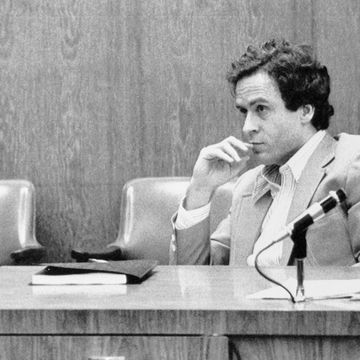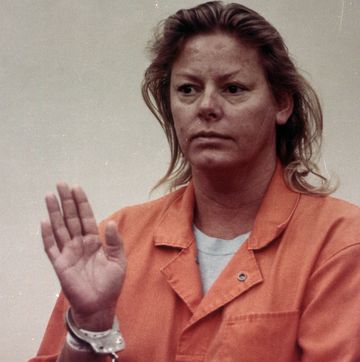Key Takeaways:
- Over the course of six months in 1999, four women and girls were murdered in and around Yosemite National Park.
- The FBI initially didn’t believe the cases were connected and unwittingly had the killer, 37-year-old maintenance worker Cary Stayner, help them collect evidence.
- Days after killing his fourth victim, Stayner voluntarily confessed to his crimes and remains in prison today.
Netflix’s new hit show Untamed tells the story of federal agent Kyle Turner as he investigates a murder in California’s Yosemite National Park. The limited series is fictional, but Yosemite’s history actually does include a real serial killer: Cary Stayner, who took four lives there nearly three decades ago.
In March 1999, the FBI located the bodies of three female Yosemite tourists who’d disappeared the previous month. Stayner, then 37, was a handyman at the victims’ motel. Investigators interviewed him but didn’t consider him a potential killer at that point.
Four months later, the decapitated body of a young woman who worked at Yosemite was discovered in the park. Stayner had been seen in the area and was questioned but not arrested. It was only when the FBI conducted another interview that Stayner confessed to all four murders.
If Untamed has sparked your interest in real-life Yosemite murders, here’s what you need to know about Stayner and his crimes, including the family tragedy that haunted him, how he was brought to justice, and where he is today.
Stayner escaped suspicion after he killed three Yosemite sightseers
Stayner had worked a maintenance job at Cedar Lodge, a motel outside Yosemite in El Portal, California, since 1997. He wasn’t on-duty the night of February 15, 1999, having been furloughed during the off-season. But he lived at the motel and noticed a woman and two teens staying there.
Stayner lied about a leak to get inside the room then pulled a gun on 42-year-old Carole Sund; her 15-year-old daughter, Juliana “Juli” Sund; and 16-year-old family friend Silvina Pelosso. He bound all three then left the teens in the bathroom while he strangled Carole. Stayner hid Carole’s body in her rental car before sexually assaulting Silvina and Juli. He next strangled Silvina. He then took Juli to a reservoir overlook and slit the girl’s throat.
The Sunds and Silvina were soon reported missing, but FBI initially wasn’t sure if they’d run into trouble at their motel or after their departure. A few days after the murders, Stayner hoped to misdirect authorities by dropping Carole’s wallet in Modesto, California. During the investigation, Stayner, who had no criminal history aside from a 1997 arrest for marijuana possession, was so off the FBI’s radar that he helped them collect blanket samples for evidence.
On March 18, 1999, a torched car was spotted near Long Barn, California, about 100 miles from the Cedar Lodge motel. The next day, the FBI found Carole and Silvina’s burned bodies inside the trunk. Stayner then sent the FBI an anonymous letter with a map directing them to Juli’s body, which investigators located on March 25.
As the case became a murder investigation, the FBI investigation focused on two half-brothers with extensive criminal histories who lived close to where Carole’s wallet was found. In June, the Bureau announced they had the Sund-Pelosso murderers in custody on other charges.
Stayner’s vehicle was seen near his next Yosemite murder
Seemingly in the clear, Stayner struck again on July 21, 1999. That day, a Wednesday, he spotted 26-year-old naturalist Joie Armstrong in front of her cabin in Yosemite and threatened her with his gun. He started to drive off with a bound Armstrong, but she threw herself out of his car and tried to run. Stayner killed her during a struggle then beheaded her. Her remains were found the next day.
After Armstrong’s murder, a witness said they’d spotted Stayner’s vehicle near the scene of the crime. The FBI questioned Stayner but didn’t detain him. At the time, FBI agent James Maddock said the Bureau didn’t believe there was a connection between the Sund-Pelosso and Armstrong murders.
Yet investigators realized they needed to interview Stayner again as a potential material witness. He’d left the Cedar Lodge motel, but on Saturday, July 24, agents tracked him to a nudist colony and brought him to the FBI’s offices in Sacramento for another interview.
Stayner confessed to the FBI and then on TV
The agent who drove Stayner to Sacramento was special agent Jeff Rinek, who felt he formed a connection with the handyman on the drive. Inside the FBI offices, Stayner stunned Rinek when he offered to confess.
While being recorded, Stayner admitted to killing Armstrong. He next claimed responsibility for murdering the three Yosemite tourists. Stayner also told the FBI he’d wanted to kill his girlfriend and her two daughters but didn’t because she had a caretaker on her property.
Stayner provided confirming details and was arrested. On Monday, July 26, he was charged with Armstrong’s murder. That same day, he gave a jailhouse interview to a San Francisco TV station. He again confessed to the murders and said that as a 7-year-old boy he’d observed female cashiers at a grocery store and imagined killing them. His deadly fantasies about women had continued for 30 years.
Stayner’s confessions and arrest reignited interest in a family tragedy: In 1972, when Stayner was 11, a child molester kidnapped his 7-year-old brother, Steven, from their hometown of Merced, California. He remained missing until 1980, when Steven escaped along with a 5-year-old boy his abuser had recently abducted. Yet the reunion wasn’t entirely joyful for Stayner, who grew jealous of the attention his younger brother received.
His lawyers said Stayner killed because he lost control
Because Stayner killed Armstrong inside Yosemite, he faced federal charges for her death. He pleaded guilty to her murder and, on November 30, 2000, received a life sentence without the possibility of parole.
In 2002, Stayner was tried in state court for first-degree murder for killing the Sunds and Pelosso. He pleaded not guilty by reason of insanity. Stayner’s defense team conceded he was the murderer but argued that he should be found guilty of second-degree murder because his mental state meant he wasn’t in control of his actions.
A psychiatrist’s evaluation prepared before his trial noted that Stayner had lifelong mental health issues. An adolescent Stayner’s intrusive thoughts included images of women being sexually assaulted. In addition to the trauma of his brother’s disappearance, the psychiatrist’s report said the spotlight that accompanied Steven’s return worsened Stayner’s intrusive thinking.
The jury, however, wasn’t convinced that Stayner was unable to control himself at the time of the murders. On August 26, 2002, they found him guilty on three counts of first-degree murder and other felonies that included burglary, kidnapping, and sexual assault. After the jury recommended the death penalty, a judge sentenced Stayner to death on December 12, 2002.
The Yosemite serial killer remains in prison today
Stayner began his sentence on California’s death row at San Quentin State Prison (now San Quentin Rehabilitation Center). But over the years, there have been a number of changes to the state’s death penalty practices, including Governor Gavin Newsom signing a moratorium on all executions in 2019 and a ballot measure letting condemned inmates enter the general population at secure prisons.
An online search of the state’s records this month showed that Stayner, now 63, is incarcerated at Pelican Bay State Prison in Crescent City. As a condemned prisoner he isn’t eligible for parole.
Stayner’s brother, Steven, died in a motorcycle accident in 1989, the same year his kidnapping and escape were the subject of the TV movie I Know My First Name is Steven. In his July 1999 jailhouse interview, Stayner said he’d like a TV movie to be made about his life, too. Netflix’s Untamed isn’t about Stayner, but a show about murder in Yosemite underlines how this killer’s actions haven’t been forgotten.

Sara Kettler is a Connecticut-based freelance writer who has written for Biography.com, History, and the A&E True Crime blog. She’s a member of the Writers Guild of America and also pens mystery novels. Outside of writing, she likes dogs, Broadway shows, and studying foreign languages.


















